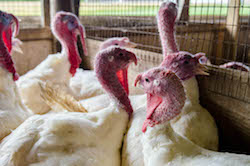SEJournal Online is the digital news magazine of the Society of Environmental Journalists. Learn more about SEJournal Online, including submission, subscription and advertising information.
TipSheet: Reporting on Turkey, Trauma-Free
Anxiety levels about turkeys ramp up this time of year. Most people worry about getting the right size bird a couple of days before Thanksgiving, or fitting it in the fridge. But turkeys actually cause consumers other anxieties — and that gives journalists a lot to write about.
Are factory-farmed turkeys bad? Where can I get a local turkey? Is it free-range? Pastured? Cruelty-free? Antibiotic-free? Organic? Sustainable? Safe to eat? Will the vegans in the family revolt?
First off, the turkey business isn’t chicken feed — it’s a $5 billion-a-year industry producing on the order of 250 million birds a year, per the Agriculture Department.
And most people still buy a big frozen turkey in the supermarket, then thaw it over a few days (defrost in the fridge for safety, please). A few dozen big companies have this market locked up. The Big Bird among them is Butterball.
 |
| Turkeys at Rocheford Turkey Farm, University of Missouri. Photo: Morgan Lieberman/College of Agriculture, Food and Natural Resources, Flickr Creative Commons |
But many supermarket turkeys are indeed produced in “factory farm” conditions (but check the label, since not all are). That means a lot of crowding, little air and exercise, and a totally controlled diet that very likely includes antibiotics.
Animal-rights groups such as PETA and others have criticized these conditions. Some of their stories are horrific. Consumers deserve enough information to support ethical choices.
Telling local turkey tales
Turkeys, for many journalists (and cooks) can be a local story. If you head to one of your local farmers’ markets, you are likely to find vendors selling local turkeys. To find markets, check here or Google “farmers markets near me.”
One nice thing about farmers markets is that you can talk to the people who make the food. Of course, you may call it “interviewing.” Remember, though, vendors can’t always spend much time with you while tending to other customers. Get contacts, visit their websites and do longer interviews later.
Local turkeys stand a much higher chance of avoiding the ills of industrial production. But they vary too, and the more the buyer knows, the better.
Here are some turkey qualities to consider:
Organic. The term “organic” is now regulated by the Agriculture Department. Applied to poultry, it requires that the feed the birds eat is itself organic. The feed can not contain antibiotics or growth hormones, and only certain additives are allowed. Any fields the birds roam on must also be organic.
Free-Range. “Free-range” turkeys are kept in barns during the night and bad weather, but can go out and browse during the day.
Pasture-Raised. “Pasture-raised” turkeys are raised in fenced pastures that are rotated at intervals. They get to scratch and peck, presumably on soil richer than bare dirt and with some bugs and grubs. These are typically small operations and the turkeys are typically even more expensive than “free-range.”
Certified Humane. “Certified Humane” is a trademarked standard owned by the group Humane Farm Animal Care and endorsed by some animal welfare organizations. The standards for turkeys are focused on minimizing cruelty and maximizing quality of life for the birds. No toe amputation (to reduce scratching each other) for these birds.
“Natural,” “Sustainable,” Local, “Humanely Raised.” These terms are not standardized or regulated. Ask vendors what specifically they mean by them.
Poultry waste, food safety are also concerns
Management of poultry waste is an environmental issue in many places. The litter from poultry may include feces, waste food, feathers, bedding and other things. This may be polluting if it leaches into water bodies, whether with nutrients, drugs and chemicals, or pathogens.
Regulation is mainly by the states and is sometimes lax. Turkeys raised on pasture and managed properly and rotated, however, are less likely to cause pollution.
Turkey is not supposed to make you sick, even if you eat too much (actually turkeys may calm anxiety after they are cooked). But food safety can be an issue.
Environmental journalists are trained to worry about things like drug-resistant bacteria caused by feeding birds antibiotics. This may be something to worry about at the ecosystem level, but consumers need not worry too much if they handle and cook birds properly.
Both journalists and consumers worry about growth hormones and possible endocrinological harm. This should not really be a worry, since it is illegal to give growth hormones to poultry in the United States. Nonetheless, vendors will often try to compete by touting their turkeys as “hormone-free.”
Bacteria are, however, an issue. The biggest food-safety issue with turkeys is the bacteria that often are left after slaughter. The Agriculture Department and the Centers for Disease Control offer much good advice to consumers about safe turkey handling.
The biggest risk-areas are thawing (maintain refrigeration), handling (don’t spread bacteria around your kitchen), cooking (get the temperature high enough), stuffing (it needs cooking to high enough temperature). And … you might not want to leave those leftovers sitting out all evening.
* From the weekly news magazine SEJournal Online, Vol. 2, No. 43. Content from each new issue of SEJournal Online is available to the public via the SEJournal Online main page. Subscribe to the e-newsletter here. And see past issues of the SEJournal archived here.













 Advertisement
Advertisement 



